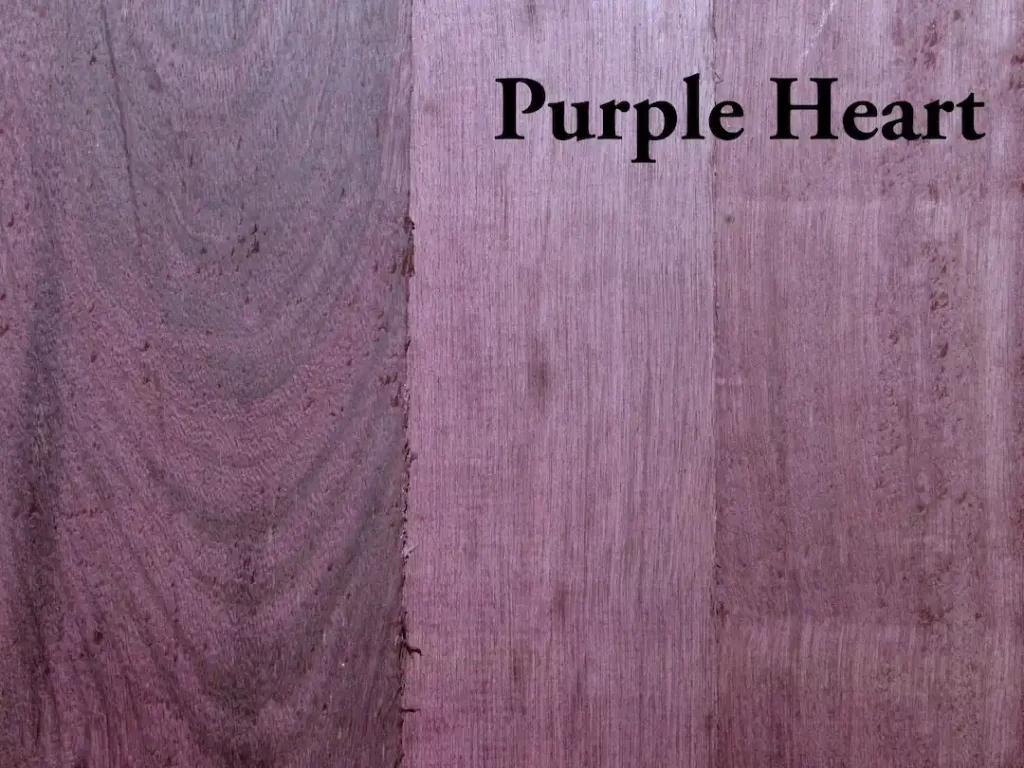Purple heart wood is a unique and interesting material that has captured the attention of woodworkers, artisans, and designers for centuries. Known for its vibrant purple hue and impressive durability, purple heart wood has a range of characteristics that make it ideal for a variety of applications.
At Capitol City Lumber yard in Raleigh, we are a trusted lumber company and hardware supplier and we’re obsessed with providing quality wood products and building supplies to our customers. Whether you’re a Raleigh local or you want to order lumber online, we can supply you with the materials you need to help you build beautiful woodcraft and home projects.
Whether you’re a woodworking enthusiast ready to order lumber online for your next project, or you’re simply curious about purple heart wood’s range of applications, we have all the details you need to understand the best ways to use purple heart wood.
What is Purple Heart Wood?
Purple heart wood is a type of hardwood that is prized for its distinctive and striking deep purple color. The scientific name of the tree that produces purple heart wood is Peltogyne, and it is found primarily in Central and South America. The heartwood of the tree is what is used in woodworking and crafting, and it gets its purple color from the high levels of natural pigments it contains.
In addition to its impressive purple hue, purple heart wood is known for its strength, durability, and resistance to decay, making it a popular choice for a variety of applications, from furniture and flooring to musical instruments and decorative items, to name a few. Because of its unique properties, purple heart wood has been used for centuries in both practical and decorative applications, and its popularity has only grown in recent years as more people discover its many benefits and beauty.
History of Purple Heart Wood
The first known uses of purple heart wood can be traced back to the indigenous people of Central and South America, who used the wood for a variety of purposes, including construction, tools, and weapons. In particular, the wood was valued for its hardness and durability, as well as its resistance to rot and insects.
During the colonial era, purple heart wood was exported to Europe, where it quickly gained popularity as a luxury material for furniture, carvings, and decorative items. In the 18th and 19th centuries, purple heart wood was especially favored by European aristocrats and royalty, who prized its rich color and rarity. In fact, purple heart wood was so highly valued that it was sometimes referred to as “kingwood” or “royal wood.”
In the 20th century, purple heart wood continued to be used in a wide range of applications, from shipbuilding and railroad ties to tool handles, such as knives and turnery, like cups and bowls. However, its popularity declined somewhat due to concerns over deforestation and the availability of alternative materials.
Today, purple heart wood is still highly prized by woodworkers, artisans, and designers for its unique color and properties. It is a popular choice for furniture, flooring, musical instruments, doors, exterior trim, jewelry, and more. Its versatility and durability continue to make it a favorite among those who work with wood. Despite its long history, the appeal of purple heart wood shows no signs of fading, and it remains a valued and cherished material for those who appreciate its beauty and craftsmanship.
Characteristics of Purple Heart Wood
Purple heart wood is most recognizable by its distinctly rich, deep purple color. But, there are other interesting characteristics that make purple heart wood a great choice for a variety of construction and creative projects.
The notable characteristics of purple heart wood are:
- Its deep, rich purple, reddish color
- A hardness score of 1860
- Tight, fine grains
- Strength
- Density
- Durability
- A weight of 800 kg/m3
- Workability
- Visual appeal
- Sustainability
Color
The color of this hardwood is one of its most distinctive and noticeable characteristics. The wood’s natural color ranges from a deep, rich purple to a reddish-purple hue, and it has a strong and vibrant color that does not fade over time. The source of the wood’s purple color comes from its high levels of pigmentation, which are created by the tree as a natural defense mechanism. These pigments, which are called anthocyanins, give the wood its unique and beautiful coloration.
Its color can vary depending on a number of factors, such as:
- The age of the wood.
- The part of the tree where the wood comes from.
- The growing conditions of the tree itself.
While color is a major selling point, it can also pose a challenge for some woodworkers. The wood’s intense color can be difficult to match, and it can also darken over time when exposed to sunlight. However, with a careful selection of stains and other finishing materials the natural beauty of the wood can be showcased in a variety of applications that are sure to catch the eye of anyone who sees it.
Density & Hardness
With a Janka hardness rating of 1860, purple heart wood is one of the hardest and most durable woods available. This hardness makes it a popular choice for applications that require strength and durability, such as flooring, decking, and outdoor furniture. The hardness of purple heart wood is due to its dense, interlocking grain structure, which gives it a high degree of strength and resistance to wear and tear. This density also makes the wood less prone to dents and scratches, which is especially useful in high-traffic areas.
While the hardness of purple heart wood can make it difficult to work with, it also means that it is less susceptible to warping and shrinking over time. This can make it a good choice for applications where stability is important, such as in boatbuilding or outdoor construction.
Durability
One of the reasons why purple heart wood is so durable is because of its natural oils, which help to protect it from moisture and insects. These oils also give the wood a natural sheen and help to prevent it from drying out and cracking over time. Additionally, purple heart wood is also highly resistant to abrasion and wear, making it a great choice for high-traffic areas, such as floors and stairs. Because of its durability, purple heart wood requires little maintenance beyond regular cleaning.
How is Purple Heart Wood Used?
There are a variety of items that are commonly made out of purple heart wood.
Here are a few examples of purple heart wood’s versatility in the ways it can be used:
- Furniture: Purple heart wood is often used to create high-end furniture, such as tables, chairs, and cabinets. The wood’s durability and resistance to decay additionally make it a popular choice for outdoor furniture.
- Flooring: Purple heart wood is hard and durable, with a deep purple color that can add a dramatic touch to any room– that’s why it’s often chosen as a great material for new flooring.
- Turnery: Purple heart wood is often used for turning projects, such as bowls, pens, and vases. Its fine grain and density make it easy to work with and give it a beautiful finish.
- Musical instruments: For centuries purple heart wood has been a popular material for a variety of musical instruments, including guitars, violins, and drums. Its resonance and tonal qualities make it great for creating rich, warm sounds.
- Decorative items: Purple heart wood’s striking color and unique appearance make it the perfect choice for decorative items such as picture frames, jewelry boxes, and sculptures.
- Knife handles: The durability and resistance to decay of purple heart wood make it able to withstand a lot of use and still look great over time, making it an often chosen wood type for knife handles or the handles of other tools.
- Exterior trim: Purple heart wood’s natural resistance to decay and insects make it a convenient and beautiful option for exterior trim on homes and other buildings as well as other outdoor wood projects.
- Dowels: Purple heart wood’s hardness and strength make it an excellent choice for creating dowels, the cylindrical rods used for holding wooden structures together.
- Jewelry: The striking color of purple heart wood makes it a popular choice for creating unique and beautiful pieces of jewelry, such as earrings, necklaces, bracelets, broaches, and more.
- Architectural millwork: Purple heart wood is often used for architectural millwork, such as door and window frames, because of its durability, resistance to decay, strength, and overall appealing visual qualities.
These are just a few examples of the many uses for purple heart wood. Its unique properties and beauty make it a versatile material that can be used in a variety of unique and creative ways.
What are the Challenges of Working with Purple Heart Wood?
While purple heart wood has many desirable characteristics, there are also some potential downsides to consider before choosing it for a project.
Here are a few cons of purple heart wood:
- Cost: Because of its unique features like color and extended durability, purple heart wood can be relatively expensive compared to other types of wood.
- Difficult to work with: Purple heart wood is a hard, dense wood, which can make it difficult to work with using hand tools for home DIY projects. It may require special saw blades and drill bits to cut and shape, while also offering challenges related to sanding and finishing.
- Sensitivity to UV light: Over time, the vibrant purple color of purple heart wood can fade when exposed to direct sunlight. This can be mitigated with proper finishing and maintenance, but it is still something to be aware of.
- Limited availability: Purple heart wood is not as widely available as some other types of wood, and it may be harder to find in certain areas. This can make it more difficult and expensive to source for a project if you do not have a local seller of purple heart wood.
- Burns easily when cutting: Purple heart wood can burn when it is being cut, especially if the saw blade is dull or if the saw is moving too slowly. When cutting purple heart wood, it is important to use sharp saw blades and to feed the wood into the saw at a steady pace to prevent burning. If the wood does start to burn, it can leave marks on the surface that may be difficult to remove. To avoid burning while cutting purple heart wood, consider hiring a professional wood-cutting contractor to safely cut your purple heart hardwood.
Contact Raleigh’s Capitol City Lumber for Purple Heart Wood Today!
Are you looking for a unique and innovative way to step up your woodworking or construction project? Consider shopping for purple heart wood from Raleigh’s premiere woodworking and wood supply provider, Capitol City Lumber.
Whether you are in need of any type of lumber or would like to inquire about our professional woodcutting services, we are here for you.
Contact us today at 919-832-6492 or fill out our online contact form to get started.



